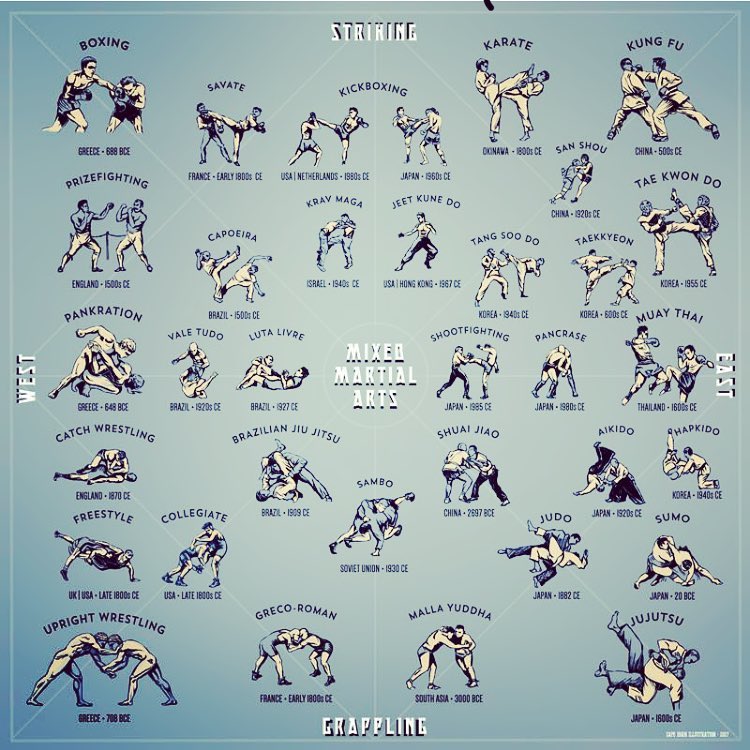Exploring The Rich Heritage And Spiritual Dimensions Of Martial Arts: A Comprehensive Evaluation
Exploring The Rich Heritage And Spiritual Dimensions Of Martial Arts: A Comprehensive Evaluation
Blog Article
Material Writer-Ryberg Wall
Enter the old globe where martial arts were substantiated of necessity in diverse areas. Societies crafted unique fighting designs linked with historical contexts. Methods developed over centuries through dedicated practice and social exchanges. Today, contemporary martial arts blend standard aspects for maximum performance. Philosophically, martial arts emphasize self-control, self-improvement, and consistency. Regard, humbleness, and balance are fundamental principles directing experts towards growth and resilience. Explore the midsts of this rich background and philosophy to uncover the profound influences forming this long-lasting discipline.
Origins of Fighting Style
Martial arts came from different regions worldwide, developing as useful battle systems to resist risks. These ancient fighting styles were developed out of necessity, with each culture crafting strategies matched to their distinct environments and challenges. From the grappling arts of Jujutsu in Japan to the striking strategies of Kung Fu in China, martial arts were deeply intertwined with the historical, social, and social material of their corresponding cultures.
In read review , the samurai class polished martial arts like Kenjutsu, the art of the sword, which later on advanced into the much more promoted kind of Kendo. Meanwhile, in Brazil, Capoeira emerged as a blend of dancing and fight, created by enslaved Africans as a way to resist oppression. Each fighting style lugs with it an abundant history and approach, reflecting the worths and beliefs of individuals who practiced them.
As you delve into the origins of martial arts, you discover a tapestry of human resourcefulness, durability, and the unrelenting spirit of warriors throughout time.
Development of Techniques
With centuries of method and improvement, combat strategies within different martial arts have actually undergone a profound advancement. From ancient styles like Kung Fu and Martial arts to more modern techniques such as Brazilian Jiu-Jitsu and Krav Maga, the evolution of strategies has been driven by a combination of cultural impacts, functional applications, and technological improvements.
One significant element of this development is the cross-pollination of methods in between various martial arts. As an example, strategies from conventional Japanese Jiu-Jitsu were integrated right into the production of Judo by Jigoro Kano in the late 19th century. This mixing of styles has caused the development of hybrid martial arts like Mixed Martial Arts (MMA), which incorporate elements of striking, grappling, and entry techniques.
Furthermore, the development of strategies has actually been shaped by the boosting emphasis on effectiveness and effectiveness in battle. Practitioners have actually constantly sought to fine-tune their techniques via rigorous training, experimentation, and competition, bring about the advancement of extremely specialized and effective battling styles. On the whole, the evolution of techniques in martial arts shows the dynamic nature of fight and the recurring quest for enhancement and advancement.
Philosophical Structures
Checking out the underlying thoughtful concepts of martial arts provides insight right into their core worths and assisting ideas. At the heart of numerous martial arts self-controls is the principle of self-control itself. By training https://small-self-defense-woman49516.dailyhitblog.com/36589745/martial-arts-and-self-defense-an-evaluation-of-their-core-differences and mind to act as one cohesive unit, you grow discipline that prolongs beyond the dojo or fitness center right into daily life. This discipline includes regard, humility, and self-constraint, forming not just your physical capacities yet additionally your character.
Another basic thoughtful structure in martial arts is the concept of constant self-improvement. aikido classes for adults of mastering a martial art is nonstop, with practitioners continuously striving to much better themselves, both literally and mentally. This focus on growth promotes strength, willpower, and a growth attitude that can be related to all elements of life.
In addition, martial arts highlight the significance of harmony and equilibrium. Strategies are created to use an opponent's power against them, highlighting the principle of producing and rerouting pressure as opposed to fulfilling it head-on. This ideology extends to social connections, advertising tranquil resolutions and mutual understanding. By accepting these philosophical foundations, martial musicians not just boost their fight abilities but also grow a lifestyle centered on individual development, respect, and consistency.
Verdict
To conclude, the history and approach of martial arts offer an abundant tapestry of tradition, technique, and self-improvement.
Consider example the tale of Bruce Lee, that reinvented martial arts by blending different styles and approaches to develop his own one-of-a-kind type of Jeet Kune Do.
With dedication and advancement, martial musicians continue to press borders and influence others to reach their complete capacity both in combat and in life.
